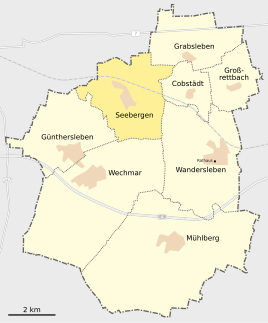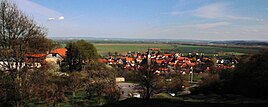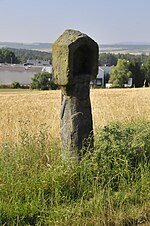Seebergen (Three of a kind)
|
Seamounts
Rural Community Three Equals
|
|
|---|---|
| Coordinates: 50 ° 55 ′ 20 ″ N , 10 ° 47 ′ 54 ″ E | |
| Height : | 288 (280-330) m |
| Area : | 8.88 km² |
| Residents : | 1231 (Oct. 5, 2015) |
| Population density : | 139 inhabitants / km² |
| Incorporation : | January 1, 2009 |
| Postal code : | 99869 |
| Area code : | 036256 |
|
Location of Seebergen in Drei Gleichen
|
|
|
The place from the Löns monument. Left in front the chaff .
|
|
Seebergen is a district of the rural community Drei Gleichen in the Thuringian district of Gotha .
geography
Seebergen is located at the eastern foot of the well-known Seeberg nature reserve , popular as an excursion and hiking destination , the highest elevation of which, the Great Seeberg , is only 500 m (horizontal) from about 290 m above sea level at 409.2 m above sea level. NN height rises. The flat, hilly terrain of the Thuringian Basin extends to the north, east and south . Apart from the wooded Seeberg, the Seebergener district has no forest areas. The only flowing water is the Rotbach , which flows through the local area in the north.
Neighboring locations are (clockwise)
| Tüttleben | Grave life | |
| Gotha with its districts Töpfleben, also separated by the landscape by the Seeberg and Siebleben |

|
Cobstädt |
| Günthersleben | Wechmar | Hiking life separated from Wechmar by the Great Seeberg |
history
Seebergen is said to have been mentioned for the first time in 1220, but so far there is no evidence for this.
The on Grieshög ( position → grave hill lying) has already been created in the New Stone Age. The grave found there is a reburial from the Hallstatt period. Bronze jewelry, spiral rings and amber beads were recovered. Seebergen formed a Vogteiamt , which as an enclave in the Duchy of Saxony-Gotha belonged to the subordinate rule of the Principality of Schwarzburg-Rudolstadt . In 1825 the Principality of Schwarzburg-Rudolstadt ceded the exclave Amt Seebergen to the Duchy of Saxe-Gotha-Altenburg , which made it part of the Gotha District Office in the Duchy of Saxe-Coburg and Gotha after 1858 .
Six young people aged 15 and 16 from Seebergen were convicted by a Soviet military tribunal in February 1946 for allegedly belonging to the " werewolf " . Two of them perished in the Soviet special camp in Sachsenhausen .
Seebergen belonged to the administrative community Drei Gleichen from 1992 to 2008 and has been part of the municipality of Drei Gleichen since January 1, 2009.
Population development
Development of the population (December 31, 2007) :
|
|
|
|
Sights and events
See also: List of cultural monuments in Drei Gleichen (municipality)
The Seeberg
- To the west of the village is the Great Seeberg with a height of 409 m above sea level. The famous Seeberger sandstone has been quarried in two quarries on the mountain for centuries . In 1067, when the Wartburg was built , Rhaetian sandstone was used. Also the Seeberger sandstone u. a. used in the construction of the Erfurt Cathedral , the Reichstag building in Berlin and the Friedenstein Palace in Gotha . By the breakdown occurred in the sandstone workers to a respiratory disease that since the 18th century as Seeberger sandstone crusher disease is called.
- On the ridge there is an NVA bunker that has since been filled in . There were missile positions on the mountain, an anti-aircraft missile system of the "51. FRBr “was stationed there.
- The first observatory in Thuringia was set up on the Großer Seeberg in the 18th century . It was destroyed by the Soviet occupation forces for military reasons.
- Halfway up the Seeberg above Seebergen is the Zum Düppel excursion restaurant , from which, in good weather, you have a beautiful view of the plain south and east of Seebergen. It was given this name in memory of the storming of the Düppeler Schanzen in 1864.
Celebrations and events
- The place is known for its traditional salad fair , which is held annually on the first weekend in July by the town's fair society.
- The fire brigade seamounts led first time in 2008 by the State Fire Banner meeting in Thuringia. From now on, these meetings will be continued in the Thuringian region every two years. All Thuringian fire brigades can apply .
- The Seeberger Flurzug , which has been taking place regularly since 1997, is the traditional continuation of the once common field and border inspections . In 2012, after a bus trip, the participants embarked on a three-hour guided hike through the Seeberg forest property near Tambach-Dietharz (“community forest”). How the village community came into possession of the forest area is unclear. (See also: How the Flurzzüge used to take place .)
Wayside shrines, stone crosses and signposts
- A shrine stands on Wanderslebener Straße in the east of the village ⊙ . It probably belongs to what was once a way of the cross with 14 stations . Another wayside shrine was found in 2013 during road construction work in the area of the intersection of the avenue and the main street at a “considerable” depth. It was broken during the dredging work, so that only the upper part remained. Its age is equated with the construction of the late Gothic Seeberger hall church, which was built in 1511. A third still preserved wayside shrine stands on the street "Am Weinberg" in the south of Seebergen, where the location is called "Holy Lehne".
- At the cemetery, at the beginning of the street "An den Steinkreuzen", there are two of them, probably from the 17th century. It is believed that they are plague columns .
- Presumably the stone markings formed a way of the cross along the "Schmalkaldische Handelsstrasse", which branched off the Via Regia (today B 7 ) northwest of Grabsleben , for example at the "Gleichenhof"
- Nearby, on Wechmarer Straße, there is a signpost with a square cross-section, which shows the way to Wechmar.
- Since April 2016, visitors to the village who come from the direction of Wandersleben have been greeted by a welcome letter on a block of Seeberger sandstone weighing several tons .
St. George Church
- The St. George Church is particularly worth seeing .
Others
In 2016, the community of Drei Gleichen set up a historical and tourist tour in Seebergen and equipped it with information boards at each of the eleven stations.
traffic
Rail transport

The station seamounts on the Thuringian Railway was built 1912th Before that, there had been a breakpoint further east since 1847, which opened up Seebergen and the neighboring town of Cobstädt . The station building was used as living space for railway employees and as ticket sales until the 1990s. After that it was empty. It was demolished at the end of 2016.
Road traffic
Seebergen is located north of the federal motorway 4 and can be reached via the Wandersleben junction . In terms of traffic, the town is also connected to the larger towns of Gotha, Wandersleben and Günthersleben-Wechmar by district roads 1 and 2. Bus connections take passengers to Wechmar, Grabsleben, Wandersleben and Gotha.
Personalities
Sons and daughters of the place
- Erhardus Sperber (1529–1608), Protestant theologian
- Julius Sperber (around 1540–1616), mystical writer, Kabbalist, isagogue and alchemist
- Johannes Bubbe (1687–1741), doctor and local researcher, Dr.-Bube-Straße is named after him.
- Johann Wilhelm Bartholomäus Rußwurm (1770–1855), Lutheran pastor and author
- Johann Georg Rußwurm (1781–1848), Lutheran pastor and author
- Ernst Anding (1860–1945), astronomer
- Marcel Wendelin (* 1939), former athlete
People related to the place
- Johann Michael Gutjahr (middle of the 18th century), German organ builder
- Wilhelm Busch , politician, headed the local branch of the NSDAP from 1928 to 1932/33
- Gustav Leutelt (1860–1947) died in Seebergen, Sudeten German poet and writer
Partnerships
Seebergen's partner municipality is Oberboihingen in Baden-Württemberg .
Trivia
The Seebergers call themselves and are called Spitzköpf by the neighboring communities . A reason for this Ortsneckname is (currently) not known.
Individual evidence
- ↑ Michael Köhler: Pagan sanctuaries. Jenzig-Verlag, 2007, ISBN 978-3-910141-85-8 , p. 140.
- ^ File about the Principality of Schwarzburg-Rudolstadt
- ^ Seebergen in the municipality register 1900
- ^ Benno Prieß: The young people from Seebergen / Thuringia. In: Shot at dawn. Co-editor: the state commissioner for the documents of the State Security Service of the GDR. Self-published, Calw 2002, ISBN 3-926802-36-7 , p. 94.
- ↑ StBA: Area changes on 01/01/2009
- ↑ Data source: Thuringian State Office for Statistics
- ↑ Our newspaper, Regionaler Vereins- und Gewerbeanzeiger , 212th edition from July / August 2013.
- ↑ Information board no. 11 "At the stone crosses".
- ↑ Lena Dickgießer: Seebergen: Deutsche Bahn has the old station building torn down , Thüringer Allgemeine , September 6, 2016







